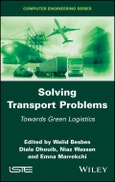Table of Contents
Preface xi
Acknowledgments xv
Chapter 1. An Adaptive Large Neighborhood Search Heuristic for the Green Dial-a-Ride Problem 1
Mohamed Amine MASMOUDI, Manar HOSNY and Emrah DEMIR
1.1. Introduction 1
1.2. Literature review 3
1.2.1. The Dial-a-Ride Problem 4
1.2.2. The green vehicle routing problem 5
1.3. Problem definition 5
1.4. An Adaptive Large Neighborhood Search for the G-DARP 10
1.4.1. Adaptive weight adjustment procedure 11
1.4.2. Removal and insertion operators 12
1.4.3. Local search operators 12
1.5. Computational experiments 13
1.5.1. Data and experimental setting 13
1.5.2. Parameters setting 14
1.5.3. Computational analysis 16
1.6. Conclusion 23
1.7. References 23
Chapter 2. Role of Green Technology Vehicles in Road Transportation Emissions - Case of the UK 27
Niaz WASSAN, Angus FURNEAUX and Said SALHI
2.1. Introduction 27
2.2. Alternative Fuel-Powered vehicles market 29
2.3. Electric vehicles - options and features 30
2.3.1. Battery relevance 36
2.3.2. Charging implications 40
2.3.3. Relevance of regenerative braking technology 44
2.3.4. Emissions 44
2.4. UK transport emissions and the impact of BEVs 47
2.5. Cost implications 55
2.6. Conclusion 56
2.7. References 57
Chapter 3. Transport Pooling: Moving Toward Green Distribution 63
Alaeddine ZOUARI
3.1. Introduction 63
3.2. Concepts of collaborative logistics 65
3.2.1. Definitions and issues 65
3.2.2. Forms of logistical collaboration 66
3.3. Pooling of physical flows between organizations 68
3.4. Literature review 69
3.4.1. Choice of articles 69
3.4.2. Analysis and discussion of the results 72
3.5. Proposal of pooling scenarios for the urban distribution of goods 75
3.6. Comparison of scenarios 81
3.6.1. Distances traveled 81
3.6.2. Greenhouse gas emissions 83
3.6.3. Distribution cost 84
3.6.4. Delivery time 85
3.6.5. Best scenario 86
3.7. Proposal for a shared long-distance distribution model 87
3.8. Conclusion 90
3.9. References 90
Chapter 4. A Ruin and Recreate Solution Method for a Lexicographic Vehicle Routing Problem Integrating Park-and-Loop and Car Sharing 97
Olivier GALLAY and Nicolas ZUFFEREY
4.1. Introduction 97
4.2. Literature review 99
4.3. Considered problem 101
4.4. Lexicographic approach 103
4.5. Solution method 104
4.6. Results 107
4.6.1. Walking 108
4.6.2. Electric kick scooter 111
4.7. Conclusion and future work 112
4.8. References 113
Chapter 5. An Overview of the Recent Solution Approaches in the Green Vehicle Routing Problem 115
Emna MARREKCHI, Walid BESBES and Diala DHOUIB
5.1. Introduction 115
5.2. Chronological progress of the literature on the GVRP 116
5.2.1. The Green-VRP 116
5.2.2. The Pollution-Routing Problem 119
5.3. Solution methodologies for the GVRP 120
5.3.1. Exact methods 120
5.3.2. Metaheuristics 123
5.3.3. Heuristics 128
5.4. Conclusion 129
5.5. References 130
Chapter 6. Multi-Criteria Decision Aid for Green Modes of Crude Oil Transportation Using MACBETH: The Sfax Region Case 135
Nouha HAMMAMI, Mohamed Haykal AMMAR and Diala DHOUIB
6.1. Introduction 135
6.2. State-of-the-art 137
6.2.1. Hazardous materials transportation integrated location and routing problem 137
6.2.2. Hazardous materials transportation risk assessment problem 138
6.2.3. Hazardous materials transportation network design problem 139
6.3. Real case: choice of crude oil transportation modal from the Sfax region to the Skhira port 142
6.3.1. Identification of the problem 143
6.3.2. Method for Measuring Attractiveness by a Categorical-Based Evaluation Technique (MACBETH) 143
6.3.3. Research methodology: MACBETH application 144
6.3.4. Results and discussions 150
6.4. Conclusion 157
6.5. References 158
Chapter 7. Green Reverse Logistics: Case of the Vehicle Routing Problem with Delivery and Collection Demands 161
Naveed WASSAN, Niaz WASSAN, Lina SIMEONOVA and Walid BESBES
7.1. Introduction and significance 161
7.2. The Vehicle Routing Problem and its variants 164
7.2.1. The evolution of the Vehicle Routing Problem 164
7.2.2. The Vehicle Routing Problem 164
7.2.3. VRP variants. 164
7.3. The VRP with delivery and collection demand models 166
7.3.1. The VRP with Mixed Deliveries and Pickups 166
7.3.2. The VRP with Simultaneous Deliveries and Pickups 166
7.3.3. The VRP with Backhauls 167
7.3.4. The Multiple-Trip Vehicle Routing Problem with Backhauls 168
7.4. Studies in VRPB-related areas. 169
7.4.1. Significance of the VRP models with delivery and collection demands 170
7.4.2. Ecological relevance of the VRP models 171
7.4.3. Computation of freight transport greenhouse gas emissions 172
7.4.4. Vehicle routing models directly focused on green transportation 174
7.4.5. Green VRP models 175
7.4.6. Electric vehicles modeling 176
7.5. Conclusion 177
7.6. References 178
Chapter 8. An Improved DTC Induction Motor for Electric Vehicle Propulsion: An Intention to Provide a Comfortable Ride 185
Fatma BEN SALEM and Moez FEKI
8.1. Introduction 185
8.2. Several components of EV motor drive 187
8.3. An overview of induction motor control strategies 188
8.4. DTC strategies 189
8.4.1. Conventional DTC fundamentals 189
8.4.2. An improvement of DTC strategy: fixed torque switching frequency 193
8.5. Comparative study based on simulation results 195
8.5.1. Steady-state and transient behavior analysis 195
8.5.2. Performance criteria 197
8.5.3. Discussion 198
8.6. Conclusion 199
8.7. References 199
Chapter 9. Optimization in Multilevel Green Transportation Problems with Electrical Vehicles 203
Marcos R. LEITE, Heder S. BERNANDINO, Luciana B. GONÇALVES and Stênio SOARES
9.1. Introduction 203
9.2. Transportation problems with electric vehicles 206
9.2.1. Multilevel formulations 207
9.2.2. Summary review of the literature 209
9.3. Search techniques 211
9.3.1. Exact optimization techniques 212
9.3.2. Genetic algorithms 213
9.3.3. Imperialism competitive algorithm 214
9.3.4. Particle Swarm Optimization 216
9.3.5. Simulated annealing 217
9.3.6. Neighborhood search 218
9.3.7. Summary review of the literature 219
9.4. Tendencies and challenges 223
9.5. Concluding remarks 225
9.6. References 226
List of Authors 229
Index 231








